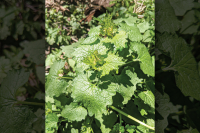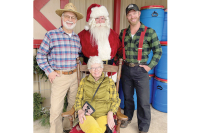First of the Floppy Disc: Almond School
 I wrote first by hand and then with a manual typewriter. Starting about 1990, I moved “up” to a Tandy writing machine generated by an IBM “Writing Assistant” program diskette that stored information on floppy discs. No hard drive. During the last decade of the 20th century (before I moved “up” again to a “real” computer), I generated a lot of floppy discs.
I wrote first by hand and then with a manual typewriter. Starting about 1990, I moved “up” to a Tandy writing machine generated by an IBM “Writing Assistant” program diskette that stored information on floppy discs. No hard drive. During the last decade of the 20th century (before I moved “up” again to a “real” computer), I generated a lot of floppy discs.
To my knowledge (which is limited), computers no longer come with designated floppy capability. I was told I needed a “Floppy Drive Module” that plugs into a computer port to access those forgotten words. So I got one. It’s about the size of a large billfold. Lots of the files are gibberish, with texts of random letters and numbers that look like a deranged accountant’s spreadsheet.
But some of it — for better or worse — is pretty much what I wrote going on 20 to 30 years ago. None is of historical or literary consequence, but some is perhaps of regional interest.
From time to time, I’ll spruce up a selection from The Floppy Dick Chronicles and reintroduce it in this space. This first one is about the 1995 reunion of the last class to graduate from the Almond High School, which was inundated by the waters of Lake Fontana in 1945.
Almond doesn’t exist anymore. Where the village was situated is now submerged underneath the waters of Lake Fontana at the present location of the Almond Boat Dock just off Highway 28 west of Bryson City.
Related Items
But several weeks ago, it was very much alive in the memories of more than 200 persons who gathered on the banks of the lake for a homecoming dinner celebrating the 5th annual reunion of the graduates of Almond High School.
Not all 200 had graduated from the little school, of course, but their parents or grandparents or other relatives had — and all seemed to know Almond’s story.
One family had come from Oregon for the reunion, and many others had come from throughout the Southeast. Mostly, they came from Swain and adjoining counties.
Almond was incorporated in 1905. It was named for Bud Almond, who donated the land for the town’s site on the Nantahala River just above its confluence with the Little Tennessee.
The Cherokee lived here first. The most famous of these was the Cherokee martyr Tsali, who had his farm somewhere nearby — no one seems to know just where.
Fort Lindsay, the westernmost stockade in Gen. Winfield Scott’s Indian removal system, was located here, and several U.S. soldiers’ graves dating from the late 1830s are marked up on the hill. No one seems to be able to account for just how or why they died.
The village of Almond grew up on the Southern Railway line that passed through in the mid-1880s on its way from Asheville to Murphy, which it reached in 1891 after sustaining serious delays in getting out of the Nantahala Gorge.
A railway prospectus entitled “The Western North Carolina Section At A Glance,” issued in 1912, specifies that the Almond depot was 85.1 miles from Asheville, 38 miles from Murphy, and had an elevation of 1,590 feet.
“This is the location of what, in the future, promises to be really important lumbering and mining operations,” the prospectus writer predicted. “A post office is located here which serves the surrounding mountain territory three times each week with mail by rural carriers. The Nantahala Valley, in which the village is located, is marvelously fertile and contains some of the best agricultural lands in this part of the state. While much of this land is under cultivation at present, thousands of acres of it are awaiting the hand of your husbandman to put it to blossom.”
The document goes on to describe the stations of Judson, Whiting, Bushnell, Forney, Noland, and Epps Springs — all situated between Almond and Bryson City on the railway as it ran before Lake Fontana was created, and all now under the waters, too.
In addition to the depot and post office, Almond just after the turn of the century had a general store and boarding house in addition to a school building down next to the tracks. The community’s residents decided in 1912 that they needed a better school and built a three-room structure up on Fort Hill above town where the old 1830s removal-era graves mentioned above are located.
A lively description of this period is provided by the school’s first principal, H.W. Latshaw, in a letter he wrote in 1937 to Lillian Thomason, who incorporated it into her 1965 history of Swain County:
“Within five minutes of my arrival at the Conley’s, where I was to live, I had quickly thumb-tacked to the wall two pictures, one of Washington and one of Lincoln … Miss Dess Cunningham and Miss Mattie Woodard taught the intermediate and primary grades respectively, while I was ‘the high school.’ That first year the high school was really the seventh grade. Stumps began to come out of the ground, systematic teaching cleared ‘stumps’ from the minds, and the year was under way ... ‘When you speak of the school, say something good of it,’ was my constant request. I was afraid of mountain politics and stayed out of all political contests (but then) in the interests of education, I became political and lost an election to make Almond a township farm-life school. We essayed Moonlight School for the grown-ups, but they would have none of it. Being lonely for city ways, I put in a tennis court. It was of indifferent appeal, but helped me a lot.”
A surveying crew from the Aluminum Company of America helped the principal give a “series of entertainments raising money to buy things for the school and to ‘ceil’ the inside of the church building.”
Latshaw remembered one of the boys playing Rubinstein’s “Melody in F” on a one-string violin made on an old broom. The class of 1917 was the first to receive high school diplomas. There were five graduates: Bertha and Esther Cunningham, Mary Campbell, William C. White, and George Henry Taylor. Only Mary Campbell, who went on to make her mark in the business world in Richmond, Virginia, as Mary Sutherland, is still living. She will celebrate her 90th birthday in Bryson City later this year.
Latshaw went on to receive his doctorate and become a distinguished teacher of the handicapped in Baltimore. He was followed by other accomplished teachers like Mildred Penland Wood, Gary T. Winchell, E.J. Carter, Harley Lovingood, and a French teacher called “Miss Josie,” who coached the school’s boys basketball to the “county pennant” in the mid-1930s.
There was, according to the old-timers attending the reunion, something about the Almond School and the support it received which drew good teachers to the community. In turn, the school drew students from surrounding communities like Judson, Roundhill, Wesser, Silvermine, Hewitt, Hightower, Patterson Springs, Grassy Branch, Parched Corn, Maple Springs, and parts of Alarka.
The school house on the hill was gradually expanded and an auditorium added; then, because of the success of the school and consolidations taking place in the county, a new building was constructed in 1925.
This imposing two-story structure with six columns at the entrance saw its last graduating class of nineteen students in 1945 just before it quite literally went under.













